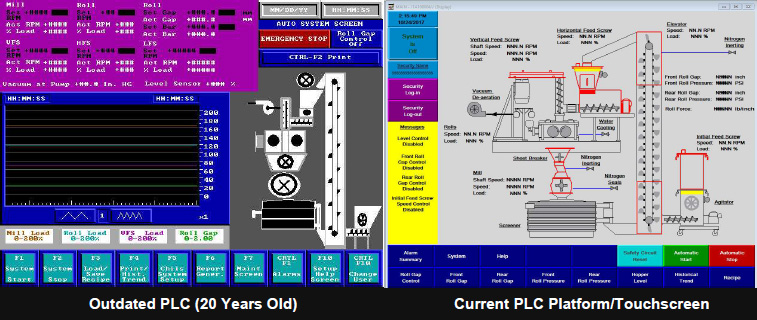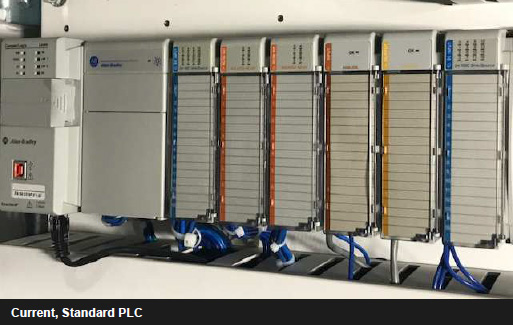How Old are the PLC Controls on your Roll Compactor/Mill?
While you may have recently upgraded your HMI (touchscreen), it is important to understand that the PLC controls are the heart of your operation. This update is often overlooked due to high cost, however without these controls your production comes to a complete halt. Here are some tips to consider in the long term.
- PLC Life Expectancy = 15-20 years
- Discontinued PLC cards are no longer available
- Production loss can be significant if your PLC fails
Important Note
When planning & budgeting for your PLC upgrade, consider control sensors. These will need to be replaced as most will no longer be compatible with the new PLC controls.
Improved Capabilities
Improved Capabilities Newer PLC systems lend more flexibility to customize your system requirements with the addition of on-screen software timers, which are no longer embedded within the program, and improved trouble shooting capabilities to quickly diagnose an issue. All of these changes will yield a more consistent, quality final product.

Considerations
The foundation to a successful PLC upgrade is the planning.
- Determine if your current control sensors will be compatible with the new PLC platform.
- Modify the standard program for your specific installation.
- Planned shut down in production to allow time for installation and commissioning of the new hardware/software.
Planning Ahead
If the controls on your equipment have become obsolete, it can pose a high risk to your business. Sudden PLC failures can result in the need for obsolete parts leading to system shut down, loss of production, and an additional expense to expedite replacement of controls. While unexpected shut downs tend to happen at inconvenient times, a planned shut down has a significantly less financial impact. It is recommended to include PLC control upgrades in your annual budget.
A More Consistent Final Product
Older control systems have fixed programs within the PLC that prohibit the operator from making changes. New systems allow greater flexibility to adjust the control parameters directly from the touch screen. This feature, in conjunction with multiple level security logins (i.e. admin, supervisor, operator, etc.), ensures continuity across operators.
Specific Software Features
- Min/Max Parameter Set Points – avoids accidentally entering an out of range number than can cause system shutdown.
- Software Alarms – adjustable timers to notify the operator that there is an upset the system. These can be warnings displayed on the screen or alerts that will initiate a sequential shutdown.
- Improved Trouble Shooting capability – each system collects historical run time data and is stored in a daily file data collection allowing an individual to analyze and diagnose an issue. Additional trouble shooting features include historical trending located in the HMI and frequency drive diagnostics.


